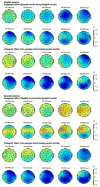Meaning first: a case for language-independent access to word meaning in the bilingual brain
- PMID: 23376051
- PMCID: PMC3640818
- DOI: 10.1016/j.neuropsychologia.2013.01.017
Meaning first: a case for language-independent access to word meaning in the bilingual brain
Abstract
This study aimed to determine how deeply a word is processed in the bilingual brain before the word's language membership plays a role in lexical selection. In two ERP experiments, balanced Spanish-English bilinguals read lists of words and pseudowords in Spanish and English, and performed in each language (1) a language-specific lexical decision task, e.g., respond to real words in Spanish, and (2) a language-specific category decision tasks, e.g., respond to Spanish words that refer to a person. In Experiment 1, infrequent words elicited larger negativity between 350 and 650 ms post-stimulus onset for both target and non-target languages. This indicates that language membership did not block lexical access of non-target words, contrary to previous findings. In Experiment 2, we measured the onset of the target-category P300 as a way of determining if words from the non-target language were temporarily treated as targets. When Spanish was the target language, the ERP waveforms diverged early based on semantic category (people versus non-people), indicating that non-target 'English people' words were briefly treated as potential targets. This finding indicates that meaning was accessed prior to using language membership for lexical selection. However, when English was the target language, the waveforms diverged first based on language (Spanish versus English) then semantic category. We argue that the order in which meaning or language membership are accessed may be based on the frequency of use of a bilingual's languages: the more frequently a language is used (English was more frequently used herein), the faster the words are identified as members of the language, and the greater interference it causes when it is not the target language. In brief, these findings make the case for a moment in processing when language membership matters less than meaning.
Copyright © 2013 Elsevier Ltd. All rights reserved.
Figures







Similar articles
-
Language Membership Identification Precedes Semantic Access: Suppression during Bilingual Word Recognition.J Cogn Neurosci. 2015 Nov;27(11):2108-16. doi: 10.1162/jocn_a_00844. Epub 2015 Jun 23. J Cogn Neurosci. 2015. PMID: 26102228 Free PMC article.
-
Accessing word meaning in two languages: an event-related brain potential study of beginning bilinguals.Brain Lang. 2003 Nov;87(2):290-304. doi: 10.1016/s0093-934x(03)00108-1. Brain Lang. 2003. PMID: 14585298
-
On predicting form and meaning in a second language.J Exp Psychol Learn Mem Cogn. 2017 Apr;43(4):635-652. doi: 10.1037/xlm0000315. Epub 2016 Sep 26. J Exp Psychol Learn Mem Cogn. 2017. PMID: 27668483
-
Processing semantic anomalies in two languages: an electrophysiological exploration in both languages of Spanish-English bilinguals.Brain Res Cogn Brain Res. 2005 Feb;22(2):205-20. doi: 10.1016/j.cogbrainres.2004.08.010. Brain Res Cogn Brain Res. 2005. PMID: 15653294
-
Solving the elusiveness of word meanings: two arguments for a continuous meaning space for language.Front Artif Intell. 2023 Jun 19;6:1025293. doi: 10.3389/frai.2023.1025293. eCollection 2023. Front Artif Intell. 2023. PMID: 37404340 Free PMC article. Review.
Cited by
-
Electrophysiological evidence of sublexical phonological access in character processing by L2 Chinese learners of L1 alphabetic scripts.Cogn Affect Behav Neurosci. 2016 Apr;16(2):339-52. doi: 10.3758/s13415-015-0394-z. Cogn Affect Behav Neurosci. 2016. PMID: 26620688
-
The Effect of Code-Switching Experience on the Neural Response Elicited to a Sentential Code Switch.Languages (Basel). 2022 Sep;7(3):178. doi: 10.3390/languages7030178. Epub 2022 Jul 11. Languages (Basel). 2022. PMID: 36188491 Free PMC article.
-
What's in the Sound? Common and Language-Specific Patterns in Brain Activation and Functional Connectivity for Phonological Awareness in Spanish-English Bilinguals.Mind Brain Educ. 2024 Aug;18(3):295-306. doi: 10.1111/mbe.12410. Epub 2024 Mar 27. Mind Brain Educ. 2024. PMID: 40765983 Free PMC article.
-
The Role of Orthotactics in Language Switching: An ERP Investigation Using Masked Language Priming.Brain Sci. 2019 Dec 31;10(1):22. doi: 10.3390/brainsci10010022. Brain Sci. 2019. PMID: 31906199 Free PMC article.
-
Fast modulation of executive function by language context in bilinguals.J Neurosci. 2013 Aug 14;33(33):13533-7. doi: 10.1523/JNEUROSCI.4760-12.2013. J Neurosci. 2013. PMID: 23946411 Free PMC article.
References
-
- Altarriba J, Basnight-Brown DM. Methodological considerations in performing semantic- and translation-priming experiments across languages. Behavior Research Methods. 2007;39(1):1–18. - PubMed
-
- Balota DA, Yap MJ, Cortese MJ, Hutchison KA, Kessler B, Loftis B, Treiman R. The English Lexicon Project. Behavior Research Methods. 2007;39(3):445–459. - PubMed
-
- Bentin S, Mouchetant-Rostaing Y, Giard MH, Echallier JF, Pernier J. ERP manifestations of processing printed words at different psycholinguistic levels: Time course and scalf distribution. Journal of Cognitive Neuroscience. 1999;11(3):235–260. - PubMed
-
- Davis CJ. N-Watch: A program for deriving neighborhood size and other psycholinguistic statistics. Behavior Research Methods. 2005;37(1):65–70. - PubMed
-
- Davis CJ, Perea M. BuscaPalabras: A program for deriving orthographic and phonological neighborhood statistics and other psycholinguistic indices in Spanish. Behavior Research Methods. 2005;37(4):665–671. - PubMed
Publication types
MeSH terms
Grants and funding
LinkOut - more resources
Full Text Sources
Other Literature Sources
Miscellaneous

